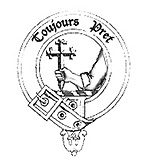Clan MacDonald of Dunnyveg
| Clan MacDonald of Dunnyveg | |||
|---|---|---|---|
 Crest: A arm bent at the elbow, with a cuffed sleeve, holding the cross, crosslet fitchee Gules | |||
| Motto | Toujours Prêt (Always Prepared) | ||
| Profile | |||
| Region | Highlands and Islands | ||
| District | Islay, Kintyre and Antrim | ||
 | |||
| Clan MacDonald of Dunnyveg no longer has a chief, and is an armigerous clan | |||
| Historic seat | Dunyvaig Castle[1] | ||
| |||
| |||
| |||
Clan MacDonald of Dunnyveg, also known as Clan Donald South, Clan Iain Mor, Clan MacDonald of Islay and Kintyre,


History
Origins of the clan
The founder of Clan Donald of Dunnyveg and the Glens was Eòin Mòr Tànaiste Mac Dhòmhnaill who was the second son of John MacDonald also known as Good John of Islay, Lord of the Isles, 6th chief of Clan Donald and 1st Lord of the Isles through his marriage to Margaret Stewart. Eòin Mòr Tànaiste Mac Dhòmhnaill married Margaret Bissett of the Glens of Antrim. From his marriage he claimed, but did not possess, this territory in Ireland, along with those he already possessed in Islay and Kintyre in Scotland. He and his descendants became known as Lords of Dunnyvaig and the Glens, although they did not possess the latter until the 16th century. Their seat in Dunnyvaig was on the Island of Islay and in the Glens they were seated at Dunluce Castle on the north Antrim coast.
Council of the Isles
The Lords of the Isles and the Council of the Isles met on Islay (pronounced Eye’ la) at Finlaggan Gaelic for white hollow. Finlaggan loch has two small islands. Upon the larger was the residence of the Lord of the Isles. The smaller of the isles was called Eilean nan Comhairle, meaning ‘council island’. The Council of the Isles met on the smaller island. The Lordship of the Isles has not governed anything like later feudal Lords governed. It was more like the Celtic kingdoms of Ireland and the Dalriadic Kingdom from which it evolved. Local chiefs elected by their clan made up the Council of the Isles. They acted as judges to settle disputes in their own clan. They were the chiefs of Clan Donald branches Dunnyveg,
15th, 16th and 17th centuries
Eòin Mòr Tànaiste was assassinated by James Campbell in 1427. His son Donald Balloch MacDonald the 2nd chief led the clan when they fought and won at the first Battle of Inverlochy (1431). This was in support of their cousin Alexander of Islay, Earl of Ross and chief of Clan Donald, 3rd Lord of the Isles.
The third Chief, Sir John Mor with his heir John Cathanach and three grandsons were apprehended through the treachery of
On the death of
Much quarrelling took place between
Further intrigue by the Clan Campbell brought the downfall of the Clan Donald of Dunnyveg and by 1620 Sir James MacDonald had lost control of Islay and Kintyre. However, during the Civil War the lands were back in the hands of the MacDonalds briefly when they were supporters of James Graham, 1st Marquess of Montrose. A notable member of the Clan MacDonald of Dunnyveg is Alasdair Mac Colla who is famed for his victories with the Royalist James Graham, 1st Marquess of Montrose during Scottish Civil War of the 1640s.[6]
The last chief, Sir James MacDonald, 9th of the Clan MacDonald of Dunnyveg or Clan Donald South died in London in 1626.
21st century
A petition was lodged on 18 May 2012 with The
Lords
- Eòin Mòr Tànaiste Mac Dhòmhnaillkilled 1427
- Dòmhnall Ballach Mac Dhòmhnailldied 1476
- Seán Mór Mac Dhòmhnaill, 3rd of Dunnyvegexecuted 1499
- Seán Cathanach Mac Dhòmhnaill, 4th of Dunnyvegexecuted 1499
- Alexander Carragh Mac Dhòmhnaill, 5th of Dunnyvegdied 1538
- Séamus Mac Dhòmhnaill, 6th of Dunnyvegdied 5 July 1565
- Archibald Mac Dòmhnuill, 7th of Dunnyvegdied circa 1569
- Aonghus mac Séamus Mac Dòmhnuill, 8th of Dunnyvegdied 21 October 1614
- Sir Séamus Mac Dòmhnuill, 9th of Dunnyvegdied 1626
Castles

- Clan MacLean at the Battle of Traigh Ghruinneart, but MacDonald was however ordered to surrender the castle and was forfeited in 1608.[1] The castle was then put under the stewardship of the Bishop of the Isles for the king, but Alasdair Colkitto MacDonald retook it in 1612.[1] In 1615 the castle passed to the Clan Campbell of Cawdor and while Alasdair Colkitto MacDonald escaped, many of his men were killed.[1] It was re-taken by Alasdair Colkitto MacDonald in 1647, but after a siege by David Leslie, 1st Lord Newark, the castle was forced to surrender when the water supply failed and Alasdair Colkitto MacDonald was finally hanged from the walls.[1] The castle was held by the Campbells of Cawdor until 1677 and the island remained with branches of the Clan Campbell.[1] The castle has mostly crumbled away but the ruins have been consolidated and can be visited.[1]
See also
References
- ^ ISBN 978-1-899874-36-1.
- ISBN 0-7179-4500-6.
- ^ "The Family Tree of the Lords of the Isles". 2010. Archived from the original on 4 July 2010. Retrieved 24 November 2010.
- ^ Fraser-MacKintosh, Charles (1895). The Last MacDonald's of Isla. Glasgow. p. 14.
{{cite book}}: CS1 maint: location missing publisher (link) - ^ William Anderson (1862). The Scottish nation: or The surnames, families, literature ...
- ^ Buchan, John (1928). Montrose: A History. Cambridge, Massachusetts: Houghton Mifflin: The Riverside Press. p. 247
- ^ "The Court of the Lord Lyon -". Archived from the original on 1 September 2017. Retrieved 1 September 2017.

